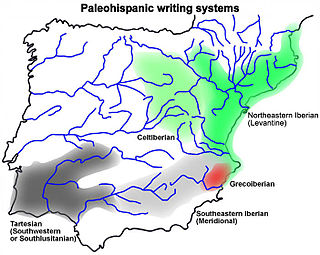 W
WConistorgis was the main city of the Conii or Cynetes. In the Conii language it probably meant "city of the Conii". The Celtici seem to have been present there.
 W
WThe Cynetes or Conii were one of the pre-Roman peoples of the Iberian Peninsula, living in today's Algarve and Lower Alentejo regions of southern Portugal, and the southern part of Badajoz and the northwestern portions of Córdoba and Ciudad Real provinces in Spain before the 6th century BCE. According to Justin's epitome, the mythical Gargoris and Habis were the founding kings.
 W
WGharb al-Andalus, or just al-Gharb, was the name given by the Muslims of Iberia to the region of southern modern-day Portugal and part of West-central modern day Spain during their rule of the territory, from 711 to 1249. This period started with the fall of the Visigothic kingdom after Tariq ibn-Ziyad's invasion of Iberia and the establishment of the Umayyad control in the territory. The present day Algarve derives its name from this Arabic name. The region had a population of about 500,000 people.
 W
WThe Kingdom of the Algarve, after 1471 Kingdom of the Algarves, was a nominal kingdom within the Kingdom of Portugal, located in the southernmost region of continental Portugal.
 W
WMadeleine Beth McCann disappeared on the evening of 3 May 2007 from her bed in a holiday apartment at a resort in Praia da Luz, in the Algarve region of Portugal. The Daily Telegraph described the disappearance as "the most heavily reported missing-person case in modern history". Her whereabouts remain unknown, and German prosecutors in 2020 have stated that they assume that she is dead.
 W
WThe history of the Kingdom of Portugal from the Illustrious Generation of the early 15th century to the fall of the House of Aviz in the late 16th century has been named the "Portuguese golden age" and the "Portuguese Renaissance". During this period, Portugal was the first European power to begin building a colonial empire as Portuguese sailors and explorers discovered an eastern route to India as well as several Atlantic archipelagos and colonized the African coast and Brazil. They also explored the Indian Ocean and established trading routes throughout most of southern Asia, sending the first direct European maritime trade and diplomatic missions to Ming China and to Japan. The Portuguese Renaissance produced a plethora of poets, historians, critics, theologians, and moralists. The Cancioneiro Geral by Garcia de Resende is taken to mark the transition from Old Portuguese to the modern Portuguese language.
 W
WThe Southwest Script or Southwestern Script, also known as Tartessian or South Lusitanian, is a Paleohispanic script used to write an unknown language usually identified as Tartessian. Southwest inscriptions have been found mainly in the southwestern quadrant of the Iberian Peninsula, mostly in the south of Portugal, but also in Spain.
 W
WThe Taifa of Santa Maria do Algarve was a medieval taifa Moorish kingdom or emirate located in what is now southern Portugal, that existed from 1018 to 1051. From 1051 until 1091, it was under the forcible control of Seville via Abbad II al-Mu'tadid. Known as the Banu Harun, their descendants remained as Qadis of the city until its reconquest by Portugal in 1249, the last of whom being Aloandro Ben Bekar.
 W
WThe Taifa of Silves was an Arab taifa kingdom that existed in what is now southern Portugal for two distinct periods: from 1027 to 1063, and again from 1145 to 1150, when it was finally conquered by the Almohad Caliphate.